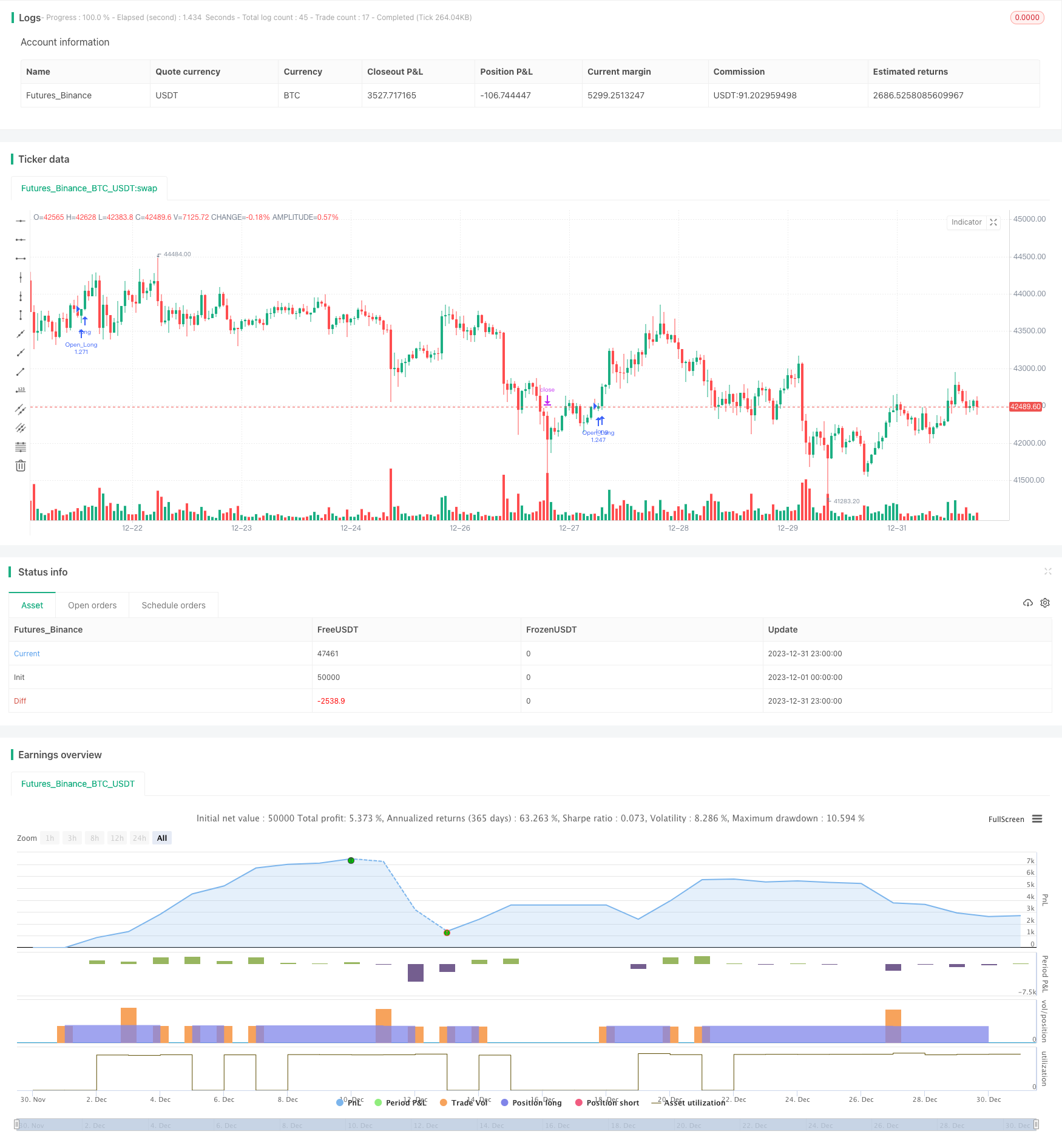
概述
本策略通过设定简单的K线形态判断规则,实现对特斯拉4小时线的长仓突破交易。策略具有实现简单、逻辑清晰、容易理解等优点。
策略原理
策略的核心判断逻辑基于如下4条K线形态规则:
- 当前K线最低价低于开盘价
- 当前K线最低价低于上一根K线的最低价
- 当前K线收盘价高于开盘价
- 当前K线收盘价高于上一根K线的开盘价和收盘价
当同时满足以上4条规则时,进行做多方向的开仓操作。
此外,策略还设定了止损位和止盈位,当价格触发止盈或止损条件时,进行平仓操作。
优势分析
该策略具有以下一些优势:
- 使用的K线判断规则非常简单和直接,容易理解,也容易实践。
- 完全基于价格实体判断,没有使用过于复杂的技术指标,回测效果直接。
- 实现代码量很小,运行效率高,容易进行优化和改进。
- 可通过参数调整,自由设置止损止盈条件,控制风险。
风险分析
需要注意的风险主要有:
- 使用固定数量开仓,没有考虑仓位管理,可能存在超量交易的风险。
- 没有设置过滤器,在震荡行情中可能会产生过多无效交易。
- 回测数据不足,可能对策略效果判断产生偏差。
可通过如下方法减轻风险:
- 加入仓位管理模块,根据资金规模动态调整交易数量。
- 增加交易过滤条件,避免在震荡盘中无序开仓。
- 收集更多历史数据,扩大回测时间长度,提高结果可靠性。
优化方向
该策略可优化的方向包括:
- 增加仓位管理模块,根据资金使用比例确定交易规模。
- 设计止损止盈追踪机制,实现弹性出场。
- 增加交易过滤模块,避免无效交易。
- 利用机器学习方法自动优化参数。
- 支持多品种套利交易。
总结
本策略通过简单的K线形态判断规则实现做多突破交易,虽然存在一定改进空间,但从简单性和直接性考量,该策略是一个非常适合初学者理解和使用的长仓策略。通过不断优化,可以使策略效果更加出色。
策略源码
/*backtest
start: 2023-12-01 00:00:00
end: 2023-12-31 23:59:59
period: 1h
basePeriod: 15m
exchanges: [{"eid":"Futures_Binance","currency":"BTC_USDT"}]
*/
// This source code is subject to the terms of the Mozilla Public License 2.0 at https://mozilla.org/MPL/2.0/
// © TheQuantScience
//@version=5
strategy("SimpleBarPattern_LongOnly", overlay=true, default_qty_type = strategy.percent_of_equity, default_qty_value = 100, currency = currency.EUR, initial_capital = 1000, commission_type = strategy.commission.percent, commission_value = 0.03)
// Make input options that configure backtest date range
startDate = input.int(title="Start Date",
defval=1, minval=1, maxval=31)
startMonth = input.int(title="Start Month",
defval=1, minval=1, maxval=12)
startYear = input.int(title="Start Year",
defval=2017, minval=1800, maxval=2100)
endDate = input.int(title="End Date",
defval=8, minval=1, maxval=31)
endMonth = input.int(title="End Month",
defval=3, minval=1, maxval=12)
endYear = input.int(title="End Year",
defval=2022, minval=1800, maxval=2100)
// Look if the close time of the current bar
// Falls inside the date range
inDateRange = true
// Setting Conditions
ConditionA = low < open
ConditionB = low < low[1]
ConditionC = close > open
ConditionD = close > open[1] and close > close[1]
FirstCondition = ConditionA and ConditionB
SecondCondition = ConditionC and ConditionD
IsLong = FirstCondition and SecondCondition
TakeProfit_long = input(4.00)
StopLoss_long = input(4.00)
Profit = TakeProfit_long*close/100/syminfo.mintick
Loss = StopLoss_long*close/100/syminfo.mintick
EntryCondition = IsLong and inDateRange
// Trade Entry&Exit Condition
if EntryCondition and strategy.opentrades == 0
strategy.entry(id = 'Open_Long', direction = strategy.long)
strategy.exit(id = "Close_Long", from_entry = 'Open_Long', profit = Profit, loss = Loss)